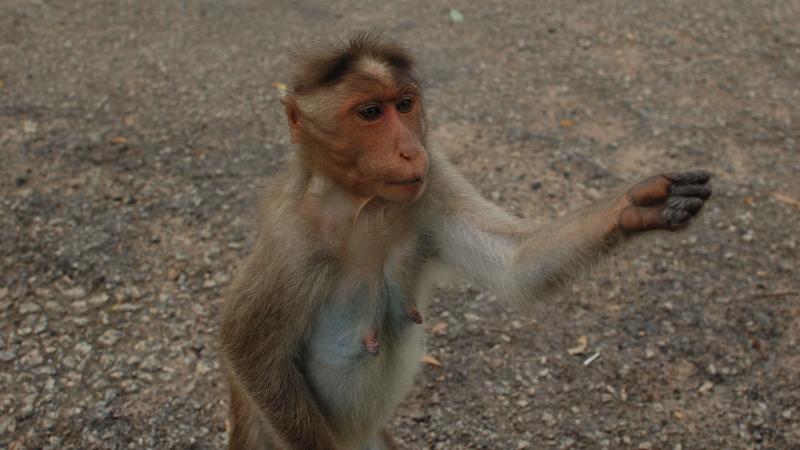
If most tourist places in India have one thing in common, it's the monkeys! Yes, these primates usually found in troops, scout for food from unassuming tourists who either may have left the windows of the cars open or have a packet of food in sight. Sometimes, they can become aggressive and snatch food, traumatising the victims! Now, a recent study from researchers at the National Institute of Advanced Studies, Bengaluru, has recorded a unique behaviour among a species of monkeys called the bonnet macaque (Macaca radiata)—a species of macaques endemic to southern India. In their long-term study, conducted at the Bandipur National Park in Karnataka, the researchers found that juvenile bonnet macaques use a system of auditory and visual signals to request human tourists for food.
If you ever owned a pet, this may not be surprising because such behaviours have been reported from animals in captivity as well. But, this research provides the first evidence of wild monkeys of any species naturally asking for food anywhere in the world. The important catch here is that these monkeys have never been taught this behaviour by humans, nor are they completely dependent on humans for food, but have learnt this behaviour on their own. The researchers of the study point out that the finding highlights the ‘intentionality’ of the monkeys to communicate with humans in a certain way to get a certain result.
“Intentionality is a cognitive ability that allows us, humans to carry out our goal-directed behaviours, including successfully communicating our intentions and desires to others”, explains Mr. Adwait Deshpande, the first author of the study published in Nature’s Scientific Reports.
During the study, the researchers observed two novel behaviours of the monkeys—a coo-call made by the monkeys, and a hand-extension gesture. While each of these behaviours has been observed in isolation in different species of monkeys, in their study, the researchers report intentionality in how the monkeys combined these two behaviours.
“The hand-extension gesture is a completely novel gesture for wild monkeys. Certain macaques, like the rhesus macaque, have been seen to show this gesture towards human caregivers, but it has never before been seen in a wild monkey and used in a natural context. In that sense, it is definitely a new gesture”, says Dr Anindya Sinha, a professor at NIAS and an author of the study.
The researchers have earlier observed similar coo-calls used by monkeys in the GKVK Campus of the University of Agricultural Sciences in Bangalore. However, the ones made by the macaques in Bandipur are louder. The monkeys seemed to use these coo-calls to attract the attention of the humans. The researchers suspect that the monkeys may have modified the ‘lost call’ that bonnet macaques often give when they are isolated from their troop, to generate these specialised coo-calls.
In this study, the researchers also observed that the coo-calls and hand-extension gestures were made more often when juvenile monkeys were tracking food-bearing humans. While the coo-calls were used to attract human attention, they extended their hands, as if to seek food, only when the monkeys had made eye-contact with the humans,. To ensure that they had a human’s attention and were able to make eye contact, the monkeys were even seen changing their vantage points. They would also continuously monitor how and where an individual was moving and repeat their behaviour once they were in direct sight of the humans.
“This is possibly the first study to report and provide evidence for directed intentional communication, involving the active use of gestures and vocalisations, in any wild monkey species”, remarks Mr. Deshpande, talking about the importance of the study. The observation of such a behaviour in non-ape primates is remarkable as it indicates the ability of these animals to develop and evolve ways, driven by their innate cognitive capacities, to successfully adapt to ecologies that have changed due to human presence and action.
“In conclusion, our study is the first attempt to explore the intentionality underlying communication between a wild monkey species and humans in a natural context, thus encouraging us to think that the precursors of human language, the most sophisticated form of intentional communicative behaviour, may possibly be evolutionarily much older than previously thought, preceding even the human-like apes such as chimpanzees”, signs off Mr. Deshpande.

![Inset: image of Snowflake yeast. Credit: Narayanasamy N, Bingham E, Fadero T, Ozan Bozdag G, Ratcliff WC, Yunker P, Thutupalli S. Metabolically-driven flows enable exponential growth in macroscopic multicellular yeast. bioRxiv [Preprint]. 2024 Jun 22:2024.06.19.599734. doi: 10.1101/2024.06.19.599734. PMID: 38948761; PMCID: PMC11213004. Yeast](/sites/researchmatters/files/styles/400px_wide/public/Snowfalke%20Yeast.jpg?itok=YZoahBjb)




